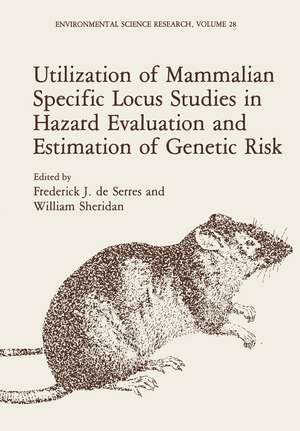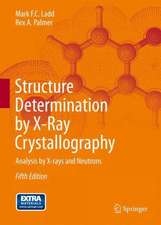Utilization of Mammalian Specific Locus Studies in Hazard Evaluation and Estimation of Genetic Risk: Environmental Science Research, cartea 28
Autor F.J. De Serresen Limba Engleză Paperback – 13 oct 2011
Din seria Environmental Science Research
-
 Preț: 405.28 lei
Preț: 405.28 lei - 15%
 Preț: 583.75 lei
Preț: 583.75 lei -
 Preț: 413.76 lei
Preț: 413.76 lei -
 Preț: 386.81 lei
Preț: 386.81 lei -
 Preț: 391.61 lei
Preț: 391.61 lei -
 Preț: 403.53 lei
Preț: 403.53 lei -
 Preț: 398.74 lei
Preț: 398.74 lei -
 Preț: 405.06 lei
Preț: 405.06 lei -
 Preț: 397.59 lei
Preț: 397.59 lei -
 Preț: 410.66 lei
Preț: 410.66 lei -
 Preț: 410.88 lei
Preț: 410.88 lei -
 Preț: 391.02 lei
Preț: 391.02 lei - 15%
 Preț: 656.25 lei
Preț: 656.25 lei - 18%
 Preț: 1253.54 lei
Preț: 1253.54 lei - 15%
 Preț: 602.40 lei
Preț: 602.40 lei - 5%
 Preț: 387.58 lei
Preț: 387.58 lei -
 Preț: 409.89 lei
Preț: 409.89 lei -
 Preț: 406.80 lei
Preț: 406.80 lei -
 Preț: 415.29 lei
Preț: 415.29 lei -
 Preț: 426.06 lei
Preț: 426.06 lei -
 Preț: 405.53 lei
Preț: 405.53 lei -
 Preț: 406.05 lei
Preț: 406.05 lei -
 Preț: 403.15 lei
Preț: 403.15 lei -
 Preț: 409.13 lei
Preț: 409.13 lei -
 Preț: 433.36 lei
Preț: 433.36 lei -
 Preț: 399.50 lei
Preț: 399.50 lei - 15%
 Preț: 592.07 lei
Preț: 592.07 lei -
 Preț: 391.02 lei
Preț: 391.02 lei -
 Preț: 395.85 lei
Preț: 395.85 lei - 5%
 Preț: 1106.33 lei
Preț: 1106.33 lei -
 Preț: 391.79 lei
Preț: 391.79 lei - 5%
 Preț: 378.97 lei
Preț: 378.97 lei -
 Preț: 395.09 lei
Preț: 395.09 lei - 15%
 Preț: 670.82 lei
Preț: 670.82 lei -
 Preț: 395.85 lei
Preț: 395.85 lei - 5%
 Preț: 720.31 lei
Preț: 720.31 lei -
 Preț: 452.04 lei
Preț: 452.04 lei - 18%
 Preț: 1834.77 lei
Preț: 1834.77 lei -
 Preț: 399.50 lei
Preț: 399.50 lei - 18%
 Preț: 953.20 lei
Preț: 953.20 lei - 15%
 Preț: 664.61 lei
Preț: 664.61 lei - 18%
 Preț: 951.77 lei
Preț: 951.77 lei -
 Preț: 389.31 lei
Preț: 389.31 lei - 18%
 Preț: 947.98 lei
Preț: 947.98 lei
Preț: 394.29 lei
Nou
Puncte Express: 591
Preț estimativ în valută:
75.47€ • 82.01$ • 63.44£
75.47€ • 82.01$ • 63.44£
Carte tipărită la comandă
Livrare economică 21 aprilie-05 mai
Preluare comenzi: 021 569.72.76
Specificații
ISBN-13: 9781461337416
ISBN-10: 1461337410
Pagini: 352
Ilustrații: 341 p.
Dimensiuni: 170 x 244 x 18 mm
Greutate: 0.56 kg
Ediția:Softcover reprint of the original 1st ed. 1983
Editura: Springer Us
Colecția Springer
Seria Environmental Science Research
Locul publicării:New York, NY, United States
ISBN-10: 1461337410
Pagini: 352
Ilustrații: 341 p.
Dimensiuni: 170 x 244 x 18 mm
Greutate: 0.56 kg
Ediția:Softcover reprint of the original 1st ed. 1983
Editura: Springer Us
Colecția Springer
Seria Environmental Science Research
Locul publicării:New York, NY, United States
Public țintă
ResearchCuprins
Session I. Introduction.- How Much Progress this Time?.- Session II. Detection of Specific Locus Mutations in Somatic Cells.- Human Mutagenicity Monitoring: Studies with 6-Thioguanine Resistant Lymphocytes.- Detection of Somatic Mutants of Hemoglobin.- Counting of RBC Variants Using Rapid Flow Techniques.- Biochemical Approaches to Monitoring Human Populations for Germinal Mutation Rates: II. Enzyme Deficiency Variants as a Component of the Estimated Genetic Risk.- Session III. Human Monitoring — Detection of Specific Locus Mutations in Germ Cells.- Biochemical Approaches to Monitoring Human Populations for Germinal Mutation Rates: I. Electrophoresis.- Session IV. Utilization of Model Systems in Mice: Part I.- The Detection of ENU-Induced Mutants in Mice by Electrophoresis and The Problem of Evaluating the Mutation Rate Increase.- Relation of Mouse Specific Locus Tests to Other Mutagenicity Tests and to Risk Estimation.- The Detection of Induced Recessive Lethal Mutations in Mice.- Session V. Utilization of Model Systems in Mice: Part II.- Using Inversions to Detect and Study Recessive Lethals and Detrimentals in Mice.- Cataracts — Indicators for Dominant Mutations in Mice and Man.- Applications in Genetic Risk Estimation of Data on the Induction of Dominant Skeletal Mutations in Mice.- Detection of Enzyme Activity Variants in Mice.- Some Factors Affecting the Mutagenic Response of Mouse Germ Cells to Chemicals.- Session VI. Detailed Analysis of Specific Locus Mutations.- Qualitative Analysis of Mouse Specific-Locus Mutations: Information on Genetic Organization, Gene Expression, and the Chromosomal Nature of Induced Lesions.- Developmental Genetics of Specific Locus Mutations.- Dominant and Recessive Effects of Electrophoretically Detected Specific LocusMutations.- Session VII. Future Directions.- Some Ideas on Future Test Systems.- Problems in Extrapolation of Animal Data to Humans.- Specific Locus Mutations in the Monitoring of Human Populations for Genetic Damage.- Some Research Needs to Support Mutagenicity Risk Assessments from Whole Mammal Studies.- Contributors.






